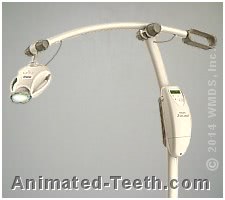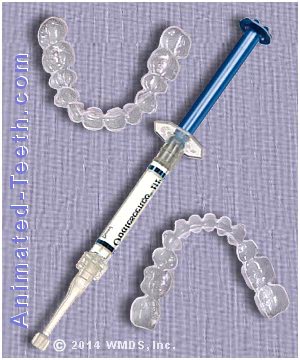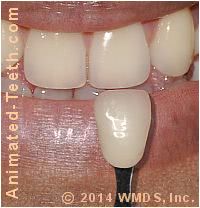How much does teeth whitening cost?
The top half of this page discusses how much dentists charge for whitening their patient’s teeth, either by performing professional (in-office) treatments or by selling you an at-home system.
The lower half of this page discusses why with any in-office system you’re likely to require more than one bleaching session.
Teeth bleaching costs –
A) Fees for in-office whitening treatments.
The price range shown below is an estimate of what a dentist might charge for a one bleaching session (professional, in-office or laser whitening, they’re all just variations of the same basic procedure).
- $390.00 – $920.00
Low fee = Small rural city or town.
High fee = Large metropolitan area.
How we calculate our cost estimates for procedures.
Notes about professional treatments:
- The fee typically includes treating both your upper and lower teeth.
Just to make sure you don’t get any surprises, you should ask about which of your teeth will be whitened. It may be limited to just the front 6 or 8 on each arch.
If you have a really big smile, this may make a difference or even be a reason not to choose this method.
- With many cases (and probably most), more than one session will be needed to achieve the level of whiteness that you’re after. (See below.)

In-office bleaching light unit.
- Dentists who include a bleaching light or laser into the procedure will have higher overhead costs than those who don’t (these units can cost may thousands of dollars). And for this reason, they may need to charge a relatively higher fee for performing treatments.
(While the use of one of these units tends to impress patients, some research suggests that the use of a bleaching light produces no benefit.)
- Some dentists may suggest that in-office sessions should be followed up with the use of an at-home whitener. If so, you can expect that there will be an additional cost for this additional treatment.
How much does your dentist pay for in-office whitening kits?
You might be curious about your dentist’s cost for materials when performing professional whitening treatments. Many manufacturers sell prepackaged, single-patient kits. They typically include whitening gel, “paint-on” dam as well as other accessories (desensitizer, lip/cheek retractors, additional disposable items).
Cost estimate for in-office whitening materials: (Your dentist’s cost.)
- One patient kit - $42.00 to $70.00
B) Fees for at-home whitening systems.
The price range shown below is an estimate of what a dentist might charge for bleaching your teeth via the use of an at-home tray-based system that they have dispensed to you.

The components of a dentist-dispensed tray whitening kit.
- $175.00 – $450.00 (per arch).
Low fee = Small rural city or town.
High fee = Large metropolitan area.In some cases, you might find that bleaching your teeth is a free service.
Notes about dentist-dispensed at-home systems:
- The fee shown is per arch, meaning either your top or bottom teeth. The price for bleaching all of your teeth would be twice the fee shown above.
- As a cost-cutting measure, you might choose to just bleach your upper teeth (single-arch treatment). Choosing this option is common. You can always bleach your second arch at a later date.
- In those cases where the type of tooth staining is severe, you can expect that the fee charged will be more. (Longer treatment time frames require the use of greater quantities of whitener and more evaluation appointments with your dentist.)
Some dentists may offer free teeth bleaching.
It certainly has caught our eye that some dentists offer their patients free teeth whitening services. However, it may be that this type of offer is only available to new patients.
As you’ll read in our next section, a dentist’s actual per-patient cost for teeth bleaching materials is quite minimal. Especially when compared to the amount of revenue that bringing new patients into a practice can generate.
What system is offered?
You might inquire about the bleaching method involved. It’s unlikely to be in-office treatments. We’d like to think that in most cases it’s simply the regular at-home method that the dentist uses with their paying customers. Usually, this would be a custom-made tray-based system (like we discuss elsewhere on this page).
In some cases, what’s offered may be no more than a box of whitening strips or possibly a prepackaged/stock tray-based kit. We won’t say that these methods can’t be effective. But if this isn’t the same type of system that the dentist uses with their patients who pay their regular bleaching fee, it makes the offer seem more gimmicky than genuine.
How much does your dentist pay for at-home whitening kits?
The cost of materials that your dentist incurs when providing you with a tray-based at-home whitening kit can be quite low, especially if the items are bought in bulk.
Cost estimate for at-home whitening materials: (Your dentist’s cost.)
- One syringe of whitening gel - $3.00 to $8.00
The price will vary depending on the volume/size of the syringe and possibly the concentration of the whitener. Most patients’ cases will require 4, or possibly more, syringes.
- A sheet of plastic to make 1 bleaching tray (upper or lower) - $1.00 to $2.00
Additional notes about the fees dentists charge for whitening teeth.
Even within the same vicinity, you can expect that different dental offices will charge different fees for the same procedure, often substantially so.
Some offices will offer a “boutique” or “spa” experience or utilize a system that’s part of an extensive nationwide advertising campaign. Others will have a more traditional approach to providing this service. As you can imagine, factors such as these can greatly affect a procedure’s pricing.
(Side note: While we do think that different dentists have different capabilities and that’s worth paying for, we’re less inclined to have much faith in any one particular brand.)
Professional in-office treatments –
A) How many whitening sessions will you need?
There is no question that in the vast majority of cases, after just a single in-office session, you should expect to see some lightening effect. However, studies suggest that:
- It typically takes more than one bleaching session to achieve “patient satisfaction” (with the range being 1 to 4 appointments).
People who are satisfied after a single session are generally those who already had a relatively light tooth coloration initially. (Gottardi 2006)
- On average, it takes 3 bleaching sessions to reach “maximum whiteness,” with a range of 1 to 6 visits. (ADA 2009)
“Maximum whiteness” is the point at which additional exposure to a whitener creates no additional lightening effect. This is the point frequently bleached to when a tray-based at-home method is used.
▲ Section references – Gottardi
If more than one session is needed, will you need to maintain a “white” diet?
It’s known that chromogenic agents, like cola, tea, coffee, red wine and dark fruits tend to cause tooth staining over time. So, generally, always minimizing your exposure to them is a good idea.
However, in regard to what’s needed during the period (days, weeks) over which you are having your whitening treatments performed (including any additional at-home treatments you are requested to perform), studies suggest that failing to do so isn’t deleterious to the level of results you will get.
We explain here: Is it necessary to maintain a “white” diet between bleaching treatments?
B) Why the results you see in your dentist’s office may not be the same ones you see at home.
The results you see in your dentist’s office immediately after the completion of your whitening session can be expected to fade. Color stabilization usually occurs within the following 2 weeks. Here’s why:
The dehydration effect.
When teeth are kept dry for an extended period of time (even as little as 30 to 60 minutes) they become desiccated (dried out). And as this dehydration effect takes place, their color lightens up.
(While most people are unaware of this phenomenon, dentists certainly have a familiarity with it. This is why when they place a white filling they will choose the color of filling material before they begin the actual treatment process, a period when the tooth needs to be kept dry.)
This type of tooth-lightening fades.
Once a desiccated tooth is exposed to moisture again (like saliva), the tooth will begin to rehydrate. As this process takes place the tooth will return to its normal, somewhat darker shade. The rehydration process may take several hours or even several days, possibly as many as three or more.
What happens during bleaching sessions.
With professional whitening treatments, the dentist takes great effort to isolate the teeth so the caustic whitener used during the bleaching process is kept away from soft oral tissues. This isolation, however, tends to desiccate the teeth being treated.
You might expect that the application of a bleaching gel would provide a moisture source for the teeth but this is not always the case. While they may look “wet,” some in-office whitening gels are non-hydrous compounds (they don’t contain water).
Why the results you see immediately after a whitening session may fade.

Using a shade guide to evaluate whitening results.
That means the dramatic improvement that your dentist oohs and aahs about on the day of your session probably isn’t as profound as they’d like you to think. A true “before and after” shade comparison can only be made if the “after” evaluation is made, some days after your whitening treatment was performed. (Reputable research studies wait at least 2 weeks.)
This is why you may be asked to continue on with at-home treatments.
The color relapse that often occurs after an in-office session is why a combined bleaching approach is often utilized. With this method, professional treatment is followed up with the use of an at-home system.
Even though the color of the teeth relapses as they rehydrate, it’s counteracted by the continued bleaching action of the at-home system. This is a well-known technique and is frequently utilized.
You’ll have to anticipate that there will be an additional cost for this additional service.
Page references sources:
Gottardi MS, et al. Number of in-office light-activated bleaching treatments needed to achieve patient satisfaction.
All reference sources for topic Professional Teeth Whitening.